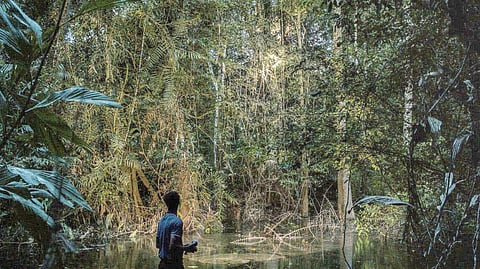

CHENNAI: The Congo Basin’s Cuvette Centrale, the world’s largest complex of tropical peatlands, covers an area slightly larger than the state of New York and stores the equivalent of three years of global carbon dioxide emissions. Like other peatlands around the world, it is a potential carbon bomb. When disturbed, these swampy freshwater landscapes unleash their carbon, trapping ever more heat in the atmosphere and intensifying global warming.
Even so, most of this region of forest and wetlands has been mapped for potential oil and gas exploration. Several areas are already being auctioned off for oil drilling by the Democratic Republic of Congo, which contains two-thirds of the peatland complex. Only about a tenth of the region lies in protected areas.
Globally, these wetlands make up only 3 percent of the earth’s land area but store twice as much carbon as all of the trees on the planet. Yet for all their importance, these landscapes have been largely forgotten in the global effort to address the climate crisis. This oversight has been hugely consequential and looms ever more so.
Peatlands are filled with deep accumulations of slowly decomposing plants and other organic material known as peat. They are carbon sinks, absorbing more carbon than they release into the atmosphere, and have been crucial in slowing planetary warming. They also absorb, filter and release rainwater slowly, helping to ease droughts and floods that have increased in severity with changes to the climate. But increasingly, these landscapes are being decimated, and global action is required to protect them — and the climate.
This coming week, that challenge is expected to be a subject of discussion among leaders from countries around the world as they convene in Sharm el-Sheikh, Egypt, for the United Nations climate conference. Hopefully this will lead to action soon; development pressures on these landscapes are intensifying.
The world’s richest countries should lead by example by protecting their own peatlands while also committing money to safeguard these landscapes in developing countries. Government and business leaders from Canada to Congo could then work together to deliver the protection required while also investing in local economies, creating jobs and defending the rights of the Indigenous and local communities that depend on peatlands.
Here’s the scope of the challenge. Roughly 15 percent of peatlands globally have already been drained, and another 5 percent to 10 percent have been degraded. Those global figures mask huge regional differences. But cumulatively, these damaged landscapes release as much as 5 percent of all of the carbon emissions caused by human activity each year.
With so much carbon at stake, the danger arises when peatlands are burned or when they are drained and then dry out, exposing the peat to oxygen-rich air, which greatly accelerates their decomposition and sends the stored carbon into the atmosphere. The fire peril was made especially clear in Indonesia in 2015, when emissions from fires set by farmers to clear forest and peatlands exceeded carbon emissions from the entire United States over dozens of days.
Peatlands are found on every continent. They range from the open, mossy high latitudes of Northern Europe, Russia, Canada and Alaska to the dark, woody tropical swamps of Southeast Asia and the Amazon Basin to the southernmost reaches of Patagonia.
Economic agendas clash with peatland protection in all of those places.
Oil exploration and development has already damaged peatlands in the western Amazon, Niger and the Sumatra basins, and now menaces the vast Congo Basin.
In Southeast Asia, peatlands have been drained to plant acacia trees to produce wood fiber, or African oil palms used in oil-based derivatives that are found in many of the products on a supermarket’s shelves. Thanks to strong government action in the region, the scale the of disturbance has diminished, but areas already drained continue to emit enormous amounts of carbon dioxide to the atmosphere.
Plans for large-scale mineral extraction in northern Canada directly threaten the world’s second-largest peatland complex — the remote Hudson Bay lowland. Vast areas, including Indigenous territories, are at risk there from proposed mining and the construction of roads and other infrastructure.
In Peru, a proposed 435-mile road from the isolated port city of Iquitos through the interior of the Amazon to the town of Saramiriza jeopardizes the hydrology supporting a large expanse of peatland; it also augurs more haphazard development that will bring its own threats.
And around the world, peat has been collected in large quantities and sold for gardening or used as fuel. That’s where the peat moss used in gardens originates.
For all of the threats, peatland restoration is gaining increasing attention and financial resources, including in the European Union, where half of the peatland has been degraded. Since 2016, Indonesia has restored several million acres of degraded peatland and is working to restore roughly two million more acres by 2024.
These efforts offer reason to cheer, and we should expand this work elsewhere. But even with the best restoration efforts, degraded peatlands won’t regain all of the carbon they have lost to the atmosphere for hundreds or even thousands of years.
The global climate crisis won’t be solved just by protecting peatlands, but it can’t be solved without them. Saving these landscapes is essential to slow the planet’s warming.
Zarin is a journalist with NYT©2022
The New York Times
Visit news.dtnext.in to explore our interactive epaper!
Download the DT Next app for more exciting features!
Click here for iOS
Click here for Android